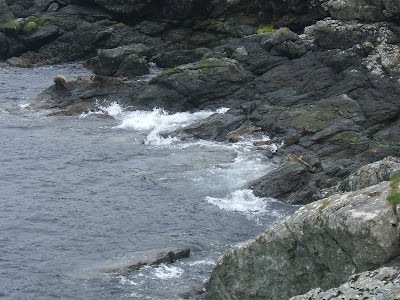Not much time for blogging at the momment, training has mainly been costal walks around the mainland, also Last 2 shetland marylins on the mainland done today approx 13kms in 3hrs. Dalescord hill 827ft and mid ward 564ft sunshine and light winds.
I have passed the 750 mile mark now with still 5 months left before leaving for base camp, hope to have reched 1500 miles before i go either by walking, cycling or rowing to make sure i give myself a fighting chance of making it
Earlier in the week did a circuit of Fethaland details below, i was followed around the coast by about a dozen seals
Details
Distance: 10.5kmDifficulty: Moderate To Challenging
Duration: 5hours
Height Gain: 100m
Area Of Shetland: North Mainland
Starting Point: HU 371 909
End Point: HU 371 909
Map: OS Explorer 469: Shetland � Mainland North West
Description
Take the track that leads to east from Isbister, stopping at the old Kirkyard to examine some rare wooden grave-markers which can still be seen, standing here among the stone ones. Continue past the Loch of Housaquoy. where interesting duck and sometimes divers can be seen here at certain times of year.
Away to the right, an ancient monastic site existed on the Kame of Isbister, an inaccessible spur of rock, jutting out seawards from the cliffs here. It featured in the TV series "Extreme Archaeology" some years ago, as did a similar site directly opposite, on the west coast of Yell. Between May and August, the wild flowers along this walk can be wonderfully varied and colourful.
The track continues up north across hill and moor, fine views of Ronas Hill to the south until you reach the remains of the old fishing lodges at Fethaland itself. This was the largest of Shetland's fishing stations. with up to sixty boats operating between here and the "Far Haaf", which was the local name for the edge of the continental shelf, about 50 miles to the west. The boats were sixerens, open, six-oared wooden vessels, built along traditional Norse lines.
Immediately to the west of the lodges an Iron Age broch once stood, its mound providing the shelter here. There are other archaeological sites nearby, including the circular wall outlines of a large Neolithic house. In the sea washed shingle strata, you can still find occasional fish bones, relics of the industry which, long ago must have transformed the area into a noisy, smelly hive of activity at the time.
Puffins sometimes nest at the northern end of the Isle of Fethaland in summer, and many shags and other seabirds nest among the cliffs and rocks. You can enjoy splendid views of Yell and the rarely accessible Gruney and the Ramna Stacks to the north.
Returning to the fishing station, you can now make your way up over the Hill of Breibister and on to the Pund of Setter the Lower Loch of Setter. Charles Ratter, the last Haaf skipper from Fethaland once crofted this very fertile area. From here the route is down to the loch and along the shore to Benigarth, with a splendid view of Sandvoe and back to Isbister.






